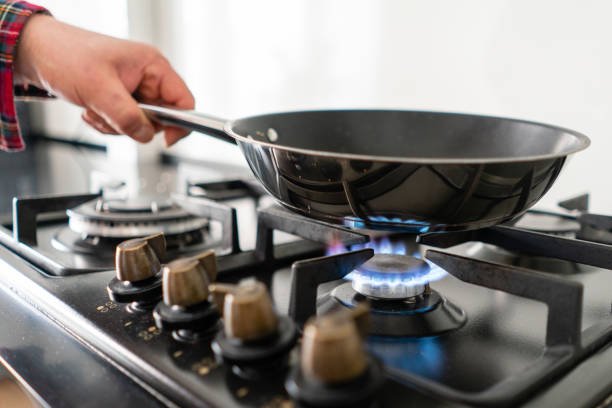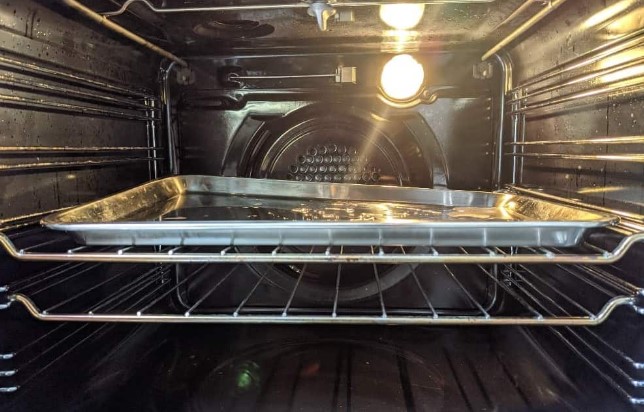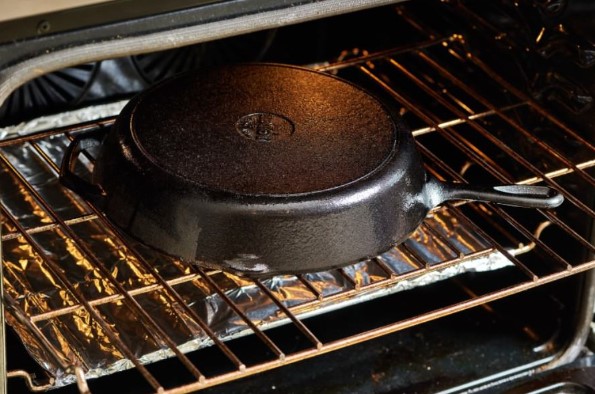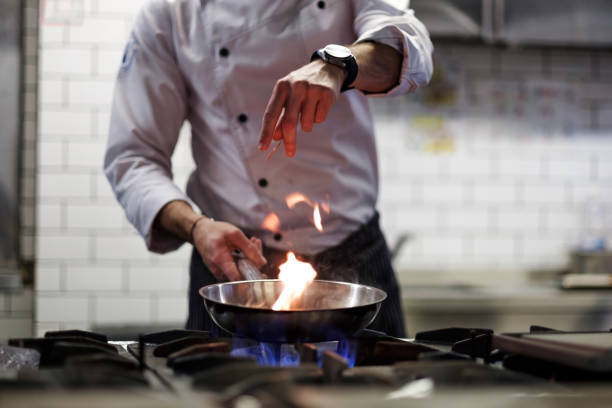In the culinary realm, where precision and perfection are paramount, there exists a vexing enigma that has confounded chefs and home cooks alike: the mysterious warping of pans.
Picture this: you’re sautéing onions to golden perfection or searing a succulent steak, only to find your once-flawless pan now resembles a whimsical funhouse mirror, its once-flat surface now contorted into an unrecognizable shape.
But fear not, for within the realm of this warped wonder lies a tale of physics, heat, and metallurgical mysteries waiting to be unraveled.
Join me as we delve into the sizzling world of kitchen chaos to uncover the secrets behind why pans warp, shedding light on this culinary conundrum with each twist and turn of the metal.

What Is A Warped Pan?
A warped pan refers to a cooking vessel, typically made of metal such as aluminum or stainless steel, that has become distorted or deformed from its original shape due to exposure to high heat or sudden temperature changes.
This distortion often leads to an uneven cooking surface, causing ingredients to cook unevenly or collect in certain areas. Warping can occur when a pan is placed on a burner that is too hot, left empty on high heat for an extended period, or exposed to cold water while still hot.
The most common signs of a warped pan include a visibly uneven base, wobbling when placed on a flat surface, or difficulty in achieving consistent cooking results.
While minor warping may not significantly impact cooking performance, severe warping can render a pan unusable and may pose safety hazards such as instability on the stovetop.
Proper care, such as avoiding extreme temperature changes and using appropriate heat levels, can help prevent pans from warping and prolong their lifespan.
Why Do Pans Warp?
Pans warp primarily due to thermal stress, which occurs when there’s a sudden or extreme change in temperature. The most common reasons for pans to warp include:
Excessive Heat
Excessive heat is one of the primary culprits behind pan warping. When a pan is subjected to very high temperatures, especially without any food or liquid inside, the metal expands rapidly.
This expansion can occur unevenly across the surface of the pan, leading to distortions in its shape. Some pans may have hot spots where heat is concentrated, causing localized expansion and potential warping in those areas.
Pans made from materials like aluminum or thin stainless steel are particularly vulnerable to warping under high heat due to their lower thermal conductivity and structural strength.
To prevent warping from excessive heat, it’s essential to use the appropriate heat level for the type of pan and cooking task at hand, avoid leaving empty pans on high heat for extended periods, and ensure even distribution of heat by using quality cookware and adjusting burner settings as needed.
Washing Your Pans with Cold Water
Washing pans with cold water while they are still hot is another common cause of warping. When a hot pan comes into contact with cold water, especially if it’s done suddenly or in large quantities, the metal undergoes rapid contraction.
This sudden contraction can cause the pan to warp, particularly if it’s made from materials like aluminum or thin stainless steel that are more susceptible to thermal stress.
The uneven cooling of the metal can lead to distortions in its shape, resulting in a pan that no longer sits flat on the cooking surface or conducts heat evenly. To avoid warping from washing with cold water, it’s essential to allow the pan to cool down gradually before rinsing it with water.
Alternatively, use lukewarm or room temperature water for washing, or wait until the pan has cooled down significantly before cleaning it to prevent thermal shock and potential warping.
Manufacturing Defects
Manufacturing defects can also contribute to pan warping, although they are less common compared to factors like excessive heat or thermal shock.
These defects may include inconsistencies in the material composition, flaws in the shaping or forming process, or insufficient quality control measures during production.
For example, if a pan is not properly tempered or annealed during manufacturing, it may lack the necessary structural integrity to withstand the stresses of cooking, leading to warping under normal usage conditions.
Similarly, if the metal used in the pan is of poor quality or has impurities, it may be more prone to warping over time. Flaws in the shaping process, such as uneven thickness or weak points in the structure, can make the pan more susceptible to distortion when exposed to heat or other stressors.
While manufacturing defects are relatively rare in high-quality cookware, they can still occur, especially in mass-produced or lower-priced pans. To minimize the risk of warping due to manufacturing defects, it’s essential to invest in reputable brands known for their quality craftsmanship and rigorous quality control processes.
Regular inspection of pans for any signs of defects or weaknesses can also help identify potential issues early and prevent warping or other problems during use.
Cooking Or Baking

Cooking or baking with certain methods can also contribute to pan warping, especially if the cookware is not suitable for the specific task or if excessive stress is applied during the cooking process.
For instance, using a pan that is too thin or lightweight for high-heat cooking methods such as searing or broiling can lead to warping due to the rapid expansion and contraction of the metal.
Similarly, placing a thin baking sheet directly on a hot oven rack without proper support may cause it to warp under the weight of heavy or unevenly distributed food items.
Furthermore, improper handling during cooking, such as using metal utensils that scratch or dent the surface of the pan, can create weak points that make it more susceptible to warping over time.
Subjecting pans to repeated thermal cycling, such as moving them between extreme temperatures frequently, can gradually weaken the metal and increase the risk of warping with each use.
To prevent warping during cooking or baking, it’s important to choose cookware that is appropriate for the cooking method and heat level being used.
Using heavy-duty pans made from durable materials like cast iron or thick-gauge stainless steel can help withstand the stresses of high-heat cooking without warping.
Using protective measures such as using parchment paper or silicone mats on baking sheets and avoiding sudden temperature changes can help prolong the lifespan of pans and prevent warping during cooking or baking.
Regular maintenance and proper storage, such as avoiding stacking heavy items on top of pans, can also help preserve their shape and integrity over time.
Low-Quality Materials
Low-quality materials used in the construction of pans can significantly contribute to warping issues. Pans made from inferior materials or those with poor craftsmanship may lack the necessary durability and resilience to withstand the rigors of cooking, leading to warping over time.
For example, pans made from thin or lightweight metals, such as low-grade aluminum or thin stainless steel, are particularly susceptible to warping when exposed to high heat or sudden temperature changes.
These materials may not have the structural integrity to resist thermal stress, causing them to deform or warp under the pressure.
Similarly, pans with inadequate coatings or finishes may be more prone to warping as they can wear down quickly, exposing the underlying metal to the elements and making it more susceptible to damage.
Non-stick coatings, in particular, can degrade over time, leading to uneven heating and warping of the pan’s surface.
Additionally, pans made from recycled or impure metals may contain inconsistencies or impurities that weaken the overall structure, making them more susceptible to warping.
Poor welding or bonding techniques can also create weak points in the pan’s construction, increasing the likelihood of distortion under stress.
To avoid warping due to low-quality materials, it’s essential to invest in high-quality cookware from reputable brands known for their superior craftsmanship and use of premium materials.
Look for pans made from thick-gauge metals with durable coatings or finishes that can withstand high heat and repeated use without warping or deforming.
Proper care and maintenance, such as avoiding extreme temperature changes and using gentle cleaning methods, can also help prolong the lifespan of pans and prevent warping due to low-quality materials.
Temperature Shock
Temperature shock, which occurs when a pan experiences rapid and extreme changes in temperature, is a significant factor contributing to warping. This phenomenon can happen when a hot pan comes into contact with a cold surface or cold liquid, causing rapid contraction of the metal.
For example, placing a hot pan directly under cold running water for cleaning or transferring a hot pan from the stovetop to a cold countertop can induce temperature shock. Similarly, adding cold ingredients or liquids to a hot pan can also create sudden temperature differentials that stress the metal.
The uneven cooling caused by temperature shock can lead to warping by creating areas of differential contraction within the pan. Over time, repeated exposure to temperature shock weakens the structural integrity of the pan, making it more prone to distortion and deformation.
To prevent warping due to temperature shock, it’s essential to allow pans to cool gradually before subjecting them to cold temperatures. Avoid placing hot pans in direct contact with cold surfaces or running them under cold water immediately after use.
Instead, allow the pan to cool down naturally or soak it in lukewarm water to gradually reduce the temperature. When cooking, try to minimize temperature differentials by preheating pans and ingredients to similar temperatures before combining them.
These precautions can help minimize the risk of warping and prolong the lifespan of your cookware.
How To Avoid Warped Pans

To avoid warped pans and ensure their longevity, consider the following tips:
Use High-Quality Cookware
Using high-quality cookware is essential for ensuring optimal cooking performance and durability. Pans made from premium materials such as stainless steel, cast iron, or heavy-gauge aluminum are less likely to warp under high heat or sudden temperature changes.
Investing in quality cookware not only enhances cooking results but also reduces the risk of warping, ensuring that your pans remain reliable and long-lasting kitchen companions.
Choose the Right Thickness
Choosing pans with the appropriate thickness is crucial to prevent warping. Opt for pans with a thicker gauge, as they offer better heat distribution and are more resistant to deformation under high temperatures.
Thicker pans also provide more stability and durability, making them less prone to warping over time. Selecting the right thickness ensures that your pans can withstand the rigors of cooking and maintain their shape for consistent performance.
Preheat Pans Properly
Properly preheating pans is essential to prevent warping and ensure even cooking. Start by heating the pan gradually over medium heat, allowing it to reach the desired temperature slowly.
Avoid heating empty pans on high heat, as this can cause uneven expansion and potential warping. By preheating your pans properly, you create a stable cooking surface that promotes consistent results and reduces the risk of damage to your cookware.
Avoid Extreme Heat
Avoiding extreme heat is key to preventing pan warping and maintaining the integrity of your cookware. Cooking with excessively high temperatures, especially with thin or low-quality pans, can lead to rapid and uneven expansion of the metal, resulting in warping.
Instead, use moderate heat levels appropriate for the type of pan and cooking task at hand. By exercising caution and avoiding extreme heat, you can prolong the lifespan of your pans and ensure they remain in good condition for longer.
Handle with Care
Handling your pans with care is crucial to prevent warping and maintain their condition. Avoid using metal utensils that can scratch or dent the surface of the pan, as these imperfections can weaken the metal and lead to warping over time.
Instead, opt for utensils made of wood, silicone, or nylon to protect the pan’s surface. Additionally, be mindful of how you store your pans, avoiding stacking heavy items on top of each other, which can cause deformation.
By treating your pans gently and with respect, you can help ensure that they remain in optimal condition for years to come.
Avoid Temperature Shock
Avoiding temperature shock is essential for preventing pan warping. Rapid changes in temperature, such as exposing a hot pan to cold water or placing it on a cold surface, can cause the metal to contract unevenly and lead to warping.
To prevent temperature shock, allow your pans to cool gradually before cleaning or exposing them to cold temperatures. Avoid adding cold ingredients to hot pans or vice versa, as this can create sudden temperature differentials.
By handling your pans with care and avoiding temperature shock, you can prolong their lifespan and maintain their quality.
Proper Cleaning and Storage
Proper cleaning and storage are essential for preventing pan warping and maintaining their condition. After each use, hand wash your pans with mild detergent and warm water, avoiding abrasive cleaners that can damage the surface.
Use non-abrasive sponges or soft cloths to gently clean the pan. Ensure the pan is completely dry before storing it to prevent moisture buildup, which can lead to corrosion.
Store pans in a dry, well-ventilated area, avoiding stacking heavy items on top of each other to prevent deformation. By adopting proper cleaning and storage practices, you can prolong the lifespan of your pans and keep them in optimal condition.
Check for Manufacturing Defects
Checking for manufacturing defects is an important step in preventing pan warping. Before using a new pan, inspect it carefully for any signs of defects such as uneven thickness, rough edges, or poor construction.
Look for inconsistencies in the material composition and ensure that the pan is free from scratches, dents, or other damage. If you notice any defects or abnormalities, consider returning or exchanging the pan for a replacement.
By checking for manufacturing defects before use, you can help ensure that your pans are structurally sound and less likely to warp during cooking.
How To Fix Warped Pans

Fixing warped pans can be challenging, but there are a few methods you can try to restore their shape:
Manual Straightening
Manual straightening is a method to fix minor warping in pans by applying pressure to the warped areas in the opposite direction of the warp. To do this, place the warped pan on a flat surface and gently press down on the affected areas using your hands or a heavy object.
Be careful not to exert too much force, as this could cause further damage to the pan. Gradually work the warped sections until the pan sits flat on the surface.
While this method can be effective for minor warping, it may not completely restore the pan to its original shape, and there is a risk of causing additional damage if not done carefully.
Heat and Weight
The heat and weight method is another technique used to fix warped pans. First, heat the pan gradually by placing it on a stovetop burner set to low heat. Allow the metal to become pliable, but be careful not to overheat it.
Once the pan is heated evenly, remove it from the heat source and place it on a flat surface. Then, apply weight to the warped areas to flatten them. This can be done by using heavy objects such as a cast iron skillet or a stack of books.
Allow the pan to cool completely while the weight presses down on the warped sections. This process helps reshape the metal and restore the pan to its original flatness. However, it’s essential to exercise caution during this process to avoid causing further damage to the pan.
Baking Method
The baking method is an effective technique for fixing warped pans using heat to reshape the metal. Start by preheating your oven to a moderate temperature, typically around 300°F (150°C).
Place the warped pan upside down on a baking sheet or oven-safe surface and place it in the oven. Let the pan heat for about 30 minutes to make the metal more pliable. Afterward, carefully remove the pan from the oven using oven mitts.
While the metal is still hot, gently reshape the warped areas by applying pressure in the opposite direction of the warp. Once you’ve adjusted the pan’s shape, place it back in the oven with a weight on top to hold it flat as it cools.
Allow the pan to cool completely before removing it from the oven. This method helps to gradually reshape the metal and restore the pan to its original flatness. However, it’s essential to handle the hot pan with care to avoid burns, and ensure proper ventilation while using the oven.
Professional Repair
For severe warping or if DIY methods fail, seeking professional repair services is a viable option to fix warped pans. Metal fabrication shops or specialty repair shops may have the expertise and equipment necessary to straighten warped pans effectively.
Professionals may use techniques such as hydraulic presses or specialized tools to carefully reshape the metal without causing further damage. They can assess the extent of the warping and provide recommendations on the best course of action.
While professional repair services may incur additional costs, they offer a reliable solution for restoring severely warped pans and ensuring their continued usability.
Why You Should Avoid Warped Pans?
There are several reasons why it’s best to avoid using warped pans:
- Uneven Cooking: Warped pans can create uneven cooking surfaces, leading to inconsistent heating and cooking results. This can result in some parts of your food being undercooked while others are overcooked.
- Poor Presentation: Foods cooked in warped pans may not have an appealing appearance due to uneven browning or cooking. This can affect the overall presentation of your dishes, especially if you’re serving guests or customers.
- Decreased Performance: Warped pans may not sit flat on the cooking surface, causing instability and inefficient heat transfer. This can result in longer cooking times and wasted energy.
- Potential Safety Hazards: Warped pans can be unstable on the stovetop, increasing the risk of spills or accidents. Additionally, sharp edges or protrusions on the pan’s surface may pose a safety hazard when handling or cleaning.
- Damage to Cooktops: Uneven pans can scratch or damage glass or ceramic cooktops over time, leading to costly repairs or replacements.
Overall, avoiding warped pans ensures better cooking performance, improved safety, and prolongs the lifespan of your cookware and kitchen appliances.
Frequently Asked Questions About Why Do Pans Warp
Why do some pans warp?
Pans may warp due to the high-quality materials used in their construction, allowing for efficient heat distribution and cooking. However, extreme temperature changes or misuse can cause slight warping, which doesn’t compromise their overall performance.
Is pan warping a sign of poor quality?
Not necessarily! In fact, modern pans are designed to withstand high heat and usage. Occasionally, slight warping can occur due to the dynamic cooking environment, but it’s a testament to the pan’s resilience rather than a mark of inferior quality.
Can a warped pan still be used effectively?
Absolutely! A slightly warped pan can still perform admirably in the kitchen. It may even add character to your cooking process, offering unique heat distribution patterns and enhancing the flavors of your dishes.
How can I prevent my pans from warping?
While warping is a natural occurrence in some cases, proper care and usage can minimize its likelihood. Avoid subjecting your pans to sudden temperature changes, and always use them within their recommended heat limits. With mindful cooking practices, you can enjoy your pans for years to come without worrying about warping.
Does pan warping affect cooking results?
Not significantly! In fact, some chefs appreciate the subtle changes in heat distribution that come with a slightly warped pan. It can add an element of unpredictability to your cooking, resulting in unique and delicious meals every time.
Can I repair a warped pan?
While it’s difficult to reverse pan warping entirely, there are some techniques you can try to mitigate it. Gentle pressure applied in the opposite direction of the warp, along with proper seasoning and maintenance, may help restore your pan’s shape to some extent.
Are there any benefits to a warped pan?
Surprisingly, yes! A warped pan can offer a more personalized cooking experience, allowing you to develop your skills by adapting to its unique characteristics. Embrace the quirks of your pan, and you may discover new culinary techniques and flavors along the way.
Should I discard a warped pan?
Not necessarily! Unless the warping significantly hinders its performance or poses safety concerns, there’s no need to part ways with your favorite pan. With a positive attitude and a bit of creativity, you can continue to create delicious meals using your trusty, albeit slightly warped, kitchen companion.
Conclusion
In conclusion, the phenomenon of pans warping is a result of various factors, including material composition, heat distribution, and usage habits.
While metal pans are particularly susceptible due to their malleable nature, even those constructed with high-quality materials can warp under extreme conditions. Factors such as sudden temperature changes, improper storage, and uneven heating contribute significantly to this issue.
User behaviors, such as rapid cooling or exposure to high heat without proper precautions, can exacerbate the likelihood of warping. Understanding these factors can guide consumers in selecting appropriate cookware and adopting practices that prolong the lifespan of their pans.
Moreover, manufacturers can continue to innovate and develop materials and designs that mitigate warping, ensuring a more durable and reliable cooking experience for consumers worldwide.